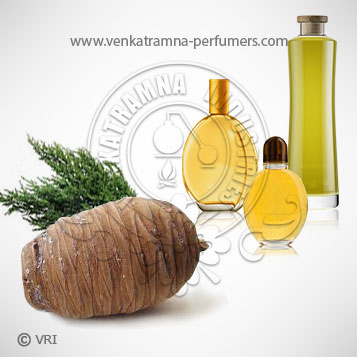
| Botanical Name | Cedrus atlantica |
| Common Name | Cedar, Weeping blue atlas cedar, Atlas cedarwood. |
| Country of Origin | India |
| Solubility | Insoluble in water |
| Specific Gravity | 0.92500 - 0.94000 @ 25°C |
| Optical Rotation | Not Applicable |
| Refrective Index | 1.50600 - 1.51600 @ 20°C |
| PlantPart | wood |
| Bland With | Rose, frankincense, neroli, cedarwood, ylang ylang, orange, bergamot clove, lavender, rosewood, rosemary, juniper berry, clary sage, herb and floral scents, bergamot, citrus oils especially grapefruit. |
| CAS No | 8000-27-9 |
| Flash Point | above 87°C |
| Extraction Method | Steam Distilled |
Cedrus atlantica is an evergreen Tree growing to 25 m (82ft) by 10 m (32ft) at a medium rate. It is hardy. It is in leaf all year, in flower in September, and the seeds ripen from October to December. The species is monoecious (individual flowers are either male or female, but both sexes can be found on the same plant) and is pollinated by Wind. It cannot grow in the shade. It prefers dry or moist soil and can tolerate drought. The plant can tolerate strong winds but not maritime exposure. It can tolerate atmospheric pollution. The wood itself is hard and strongly aromatic because of the essential oil it contains, which is obtained by steam distillation. Origination in the Atlas Mountains in North Africa, Linen chests were frequently crafted from cedar. The ancient Egyptians prized the oil, mostly for embalming purposes, but also for cosmetics and perfumery, and solomon’s temple was built with cedar wood. Today, closet liners and accessories are frequently crafted from cedar, and oil is currently used in commercial soaps, cosmetics and perfumes, especially men’s colognes.
The sacred Cedars of Lebanon and the Atlas Mountains became victim of their own popularity a long time ago. The decimation started in pre-Biblical times and still continues. At one time these grand forests of lofty Cedars must have been overwhelming in their awe-inspiring beauty. Lebanon and Atlas Cedars are large, regal trees that can live up to 2000 years. But despite their sacredness they were not protected: King Solomon ordered vast tracks to be cut down for the construction of his temple and palace and even long before his time, the Gilgamesh epic tells the story of another misguided adventurer, who abused the majestic trees for his own glory. Although he failed on account of the glory, he managed to decimate the wonderful forests. Subsequent grazing by farm animals have prevented the forest's recovery and today little of it remains in tact. A similar fate is in store for Atlas Cedar, which became the substitute for Lebanon Cedar and which at present is becoming threatened in its own habitat
Color : Yellowish to Orange with a very distinctive warm, woody aroma,
Aroma : It has a woody aroma with some camphoraceous smell.
g-Himanchalene; b-Himanchalene; (E)-a-Atlantone Gamma-Himachalene Deodarone (E)-Gamma- Atlantone Himachalol, isocedranol
Atlas Cedar is a woody evergreen plant which essential oils obtained by steam distillation have several pharmacological and aromatic properties. The essential oil is widely used in pharma, ayurvedic and soap industries. Atlas Cedar essential oil in pharma An essential oil obtained from the distilled branches is a good antiseptic and fungicide that stimulates the circulatory and respiratory systems and calms the nerves. The oil is also astringent, diuretic, expectorant and sedative. Diluted with a carrier oil such as almond and massaged into the skin it is used in the treatment of skin diseases, ulcers, chest infections, catarrh, cystitis and dandruff. It is used as an inhalant for treating bronchitis, tuberculosis and nervous tension. An infusion of the branches can also be used. Essence of Atlas Cedar essential oil An essential oil obtained from the distilled branches is used in perfumery, notably in jasmine-scented soaps. The essential oil also repels insects. Plants can be grown as a tall hedge. Wood - fragrant and durable. It is prized for joinery and veneer and is also used in construction. It is also used for making insect-repellent articles for storing textiles.